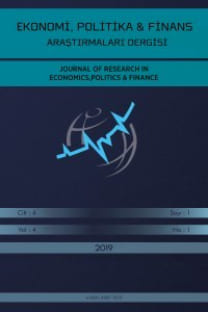Ekonomik Özgürlükler İndeks Göstergelerinin Yeni Sanayileşen Ülkelerin Kredi Notları Üzerine Etkisi
Ekonomik Özgürlük İndeksi, Ülke Kredi Notları, Panel Veri Analizi
The Effect of Economic Freedoms Index Indicators on the Credit Ratings of Newly Industrialized Countries
___
- Afonso, A. (2003). Understanding the determinants of sovereign debt ratings: evidence for the two leading agencies. Journal of Economics and Finance, 27(1), 56–74.
- Balıkçıoğlu, B., ve Yılmaz, H. H. (2019). How fiscal policies affect credit rates: probit analysis of three main credit rating agencies’ sovereign credit notes. Transylvanian Review of Administrative Sciences,56 E/February, 5-22.
- Barta, Z., and Johnston, A. (2018). Rating Politics? Partisan Discrimination in Credit Ratings in Developed Economies. Comparative Political Studies, 51(5), 587–620. https://doi.org/10.1177/0010414017710263.
- Barta, Z., and Makszin, K. (2020). The politics of creditworthiness: political and policy commentary in sovereign credit rating reports. Journal of Public Policy, 41(2), 307-330. doi:10.1017/S0143814X20000033.
- Basu, K., Bisen, A., and De, S., Ghosh, R., Shweta (2012). Comprataive Rating Index for Sovereigns: A New Index of Sovereign Credit Ratings and an Analysis of How Nations Fared over the Last Six Years. https://dea.gov.in/sites/default/files/CRIS_report_SCR28032012.pdf (Erişim Tarihi: 25.06.2022).
- Bergh, A., and Karlsson, M. (2010). Government size and growth: Accounting for economic freedom and globalization. Public Choice, 142(1), 195-213.
- Bissoondoyal-Bheenick, E. (2005). An analysis of the determinants of sovereign ratings. Global Finance Journal, 15, issue 3, p. 251-280.
- Bujang, M. A., and Baharum, N. (2016). Sample size guideline for correlation analysis. World, 3(1), 37-46.
- Cantor, R. and Packer, F. (1996), “Determinants and Impact of Sovereign Credit Rating”. [Ülke Kredi Notlarının Etkileri ve Belirleyicileri]. Federal Reserve Bank of New York Economic Policy Review, pp:37-54.
- Chang, K., and Li, Y., Shim, Y. (2022). Corporate social responsibility and credit rating around the world: The role of societal trust. Financial Review, 57, 863– 891. https://doi.org/10.1111/fire.12314.
- Chen, Y., and Puttitanun, T. (2005). Intellectual property rights and innovation in developing countries. Journal of development economics, 78(2), 474-493.
- Demmou, Lilas, Sara Calligaris, Guido Franco, Dennis Dlugosch, Müge Adalet McGowan, and Sahra Sakha. (2021). Insolvency and Debt Overhang Following the COVID-19 Outbreak: Assessment of Risks and Policy Responses.
- Feldmann, H. (2010). Government size and unemployment in developing countries. Applied Economics Letters, 17(3), 289-292.
- Gogtay, N. J., and Thatte, U. M. (2017). Principles of correlation analysis. Journal of the Association of Physicians of India, 65(3), 78-81.
- Gust, C., and Marquez, J. (2004). International comparisons of productivity growth: the role of information technology and regulatory practices. Labour economics, 11(1), 33-58.
- Gür, H.T., (2000). Ülke Riskinin Belirlenmesinde Yöntemler. Hacettepe Üniversitesi İktisadi ve İdari Bilimler Dergisi, Cilt 18, Sayı 2, 119-139).
- Hill, P., Brooks, R. and Faff, R. (2010). “Variation in sovereign credit quality assessment across rating agencies”. [Derecelendirme Kuruluşları Arasında Ülke Kredi Kalitesi Değerlendirilmesindeki Farklılıklar]. Journal of Banking and Finance 34, pp:1327-1343.
- Hu, Y. T., Kiesel, R. and Perraudin, W. (2002). Thes timation of transition matrices for sovereign credit ratings. Journal of Banking & Finance, 26(7), 1383– 1406.
- Hussain, M. E., and Haque, M. (2016). Impact of economic freedom on the growth rate: A panel data analysis. Economies, 4(2), 5.
- Kabadayı, B., ve Çelik A.A. (2015). Determinants of sovereign ratings in emerging countries: A qualitative, dependent variable panel data analysis. International Journal of Economics and Financial Issues 5: 656–62.
- Mellios, C. and Paget-Blanc, E. (2006). Which factors determine sovereign credit ratings? The European Journal of Finance 12: 361–77.
- Overes, Bart H. L., and Michel van der Wel (2021). Modelling Sovereign Credit Ratings: Evaluating the Accuracy and Driving Factors using Machine Learning Techniques. arXiv arXiv:2101.12684.
- Öztürk, H., Namli, ve E., Erdal, H. İ. (2016). Modelling sovereign credit ratings: The accuracy of models in a heterogeneous sample. Economic Modelling 54: 469–78.
- Pabuçcu, H. (2019). Ülke kredi notlarının makine öğrenme algoritmaları ile tahmini, İşletme Araştırmaları Dergisi, 11 (1), 42-51.
- Park, W. G., and Ginarte, J. C. (1997). Intellectual property rights and economic growth. Contemporary Economic Policy, 15(3), 51-61.
- Proença, C., Neves, M. Dias, J.C. and Martins, P. (2021). Determinants of sovereign debt ratings in clusters of European countries–effects of the crisis. Journal of Financial Economic Policy.
- Razmi, M. J., and Refaei, R. (2013). The effect of trade openness and economic freedom on economic growth: the case of Middle East and East Asian countries. International Journal of Economics and Financial Issues, 3(2), 376-385.
- Saadaoui, A., Elammari, A., and Kriaa, M. (2022). Credit rating announcement and bond liquidity: The case of emerging bond markets. Journal of Economics, Finance and Administrative Science.
- Takawira, O., and Muteba Mwamba J.W. (2020). Determinants of Sovereign Credit Ratings: An Application of the Naïve Bayes Classifier. Eurasian Journal of Economics and Finance 8: 279–99.
- Tatoğlu, F.Y. (2012). Panel Veri Ekonometrisi, 1. Baskı, Beta Yayınevi, İstanbul.
- https://corporatefinanceinstitute.com/resources/knowledge/economics/newly-industrialized-country-nic/ (Erişim Tarihi 27.07.2022).
- https://www.heritage.org/index/about (Erişim Tarihi 25.07.2022).
- https://www.theglobaleconomy.com/rankings/credit_rating/ (Erişim Tarihi 27.06.2022).
- Yayın Aralığı: Yılda 4 Sayı
- Başlangıç: 2016
- Yayıncı: Ersan ERSOY
Ayşegül ERTUĞRUL AYRANCI, Gizem ARI
Yeşil Tahvil ile Pay Piyasaları Arasındaki İlişkinin Çapraz Kantilogram Yöntemi ile Analizi
Kripto Paralarla Borsalar Arasındaki Volatilite Yayılımı
Zekai ŞENOL, Tuba GÜLCEMAL, Oğuz ÇAKAN
Ekonomik Özgürlükler İndeks Göstergelerinin Yeni Sanayileşen Ülkelerin Kredi Notları Üzerine Etkisi
Gizem VERGİLİ, Mehmet Sinan ÇELİK, Bahar TAŞ
Mali Kuralların ve Siyasi Yapının Etkileri: COVID-19 Krizinden Kanıtlar
Erdem KILIÇ, Sıtkı SÖNMEZER, Orhan ÖZAYDIN
Ayşegül TOY, Ayhan KAPUSUZOĞLU, Nildağ Başak CEYLAN
İlk Halka Arzların BİST100 Endeksi Volatilitesine Etkisi: Covid-19 Pandemisi Dönemi
Seçil BAYRAKTAR YETİM, Ayben KOY
Artan Kurumsal Kalite İşsizliği Azaltır mı? OECD Ülkelerinden Kanıtlar
